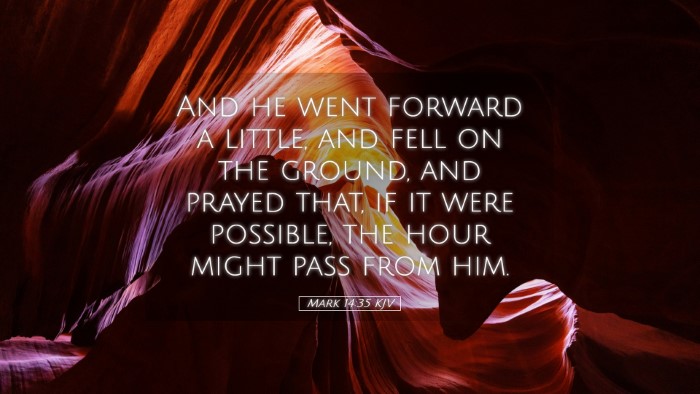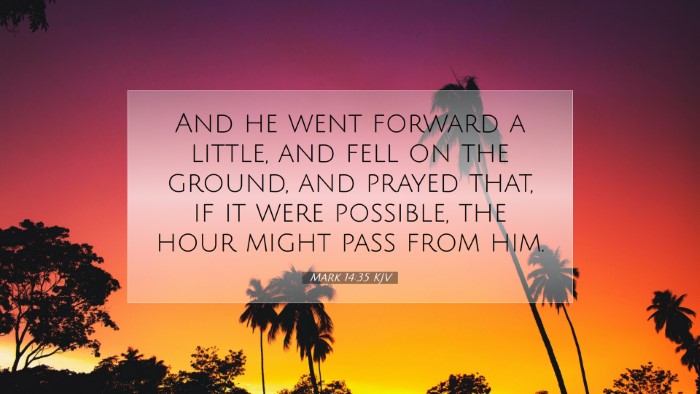Commentary on Mark 14:35
Verse Text: "And he went forward a little, and fell on the ground, and prayed that, if it were possible, the hour might pass from him." (Mark 14:35)
Introduction
Mark 14:35 captures a pivotal moment in the life of Jesus as he approaches his impending suffering and crucifixion. In this verse, we observe the profound humanity of Christ and the depths of His anguish. The insights garnered from public domain commentaries by eminent theologians like Matthew Henry, Albert Barnes, and Adam Clarke provide valuable reflections for pastors, students, theologians, and Bible scholars.
Contextual Analysis
This verse occurs in the context of Jesus’ prayer in the Garden of Gethsemane, which is a critical juncture in the Passion narrative. As the weight of sin and suffering looms over Him, Jesus is drawn to prayer in solitude. The preceding verses (Mark 14:32-34) highlight His distress, indicating that He was “sorrowful and troubled.”
Matthew Henry's Insights
Matthew Henry elaborates on the nature of the anguish Jesus faced, interpreting it as a confrontation with the sins of the world that were about to be placed upon Him. Henry emphasizes the importance of prayer in times of deep sorrow:
- Human Emotion: Henry reflects on Jesus' human emotions and their legitimacy, showing that the Savior experienced deep trouble—“He began to be sore amazed.”
- Prayer as a Refuge: Jesus went to prayer, demonstrating the necessity of seeking divine strength amidst overwhelming anguish.
- The Physicality of Prayer: Jesus fell on the ground, signifying both His deep humility and the physical manifestation of His sorrow, which underscores the seriousness of His prayer.
Albert Barnes' Commentary
Albert Barnes provides a more exegetical approach, focusing on the implications of “the hour” that Jesus prayed might pass. Barnes interprets this hour as indicative of the appointed time for His suffering and crucifixion:
- Divine Appointment: Barnes highlights that although Jesus desired relief from His suffering, He submits to the will of the Father, reflecting the dual nature of Christ—fully divine yet fully human.
- Spiritual Warfare: This moment is not just personal but cosmic; it represents the struggle between divine will and human desire, picturing the weight of sin that He bore.
- Jesus’ Humanity: Emphasizing Jesus' struggle, Barnes notes that this moment of prayer reveals the depths of His commitment to the redemptive plan, despite the horror of what was to come.
Adam Clarke's Perspective
Adam Clarke offers a theological analysis, delving into the implications of Jesus’ prayer for understanding His role in atonement. Clarke stresses:
- Nature of the “Hour”: Clarke interprets “the hour” not just as a moment of suffering but as the culmination of prophetic fulfillments from the Old Testament.
- The Seriousness of His Plea: His plea to the Father indicates a desire to avoid the impending separation from God which sin imposes—an essential part of His sacrifice.
- Model for Believers: Clarke asserts that Jesus provides a model for prayer, showing that in facing trials, believers should earnestly seek the Father for strength and guidance.
Theological Implications
This verse and its surrounding context bring forth several theological implications that are significant for understanding the nature of Christ’s work and His intimacy with the Father:
- Christ’s Humanity: This moment reveals the complexity of Christ's nature, affirming His true humanity and the emotional turmoil that accompanied His mission.
- The Role of Prayer: Jesus’ commitment to prayer amid sorrow teaches that all believers should rely on God in their most profound moments of anguish.
- Understanding Suffering: The narrative encourages reflection on how Christians understand suffering, portraying it as a pathway to redemption, not merely a scenario to escape.
Practical Applications
The emotional depth of Mark 14:35 provides rich soil for practical applications:
- Encouragement in Prayer: Pastors can encourage congregants to bring their sorrows before God as Jesus did, emphasizing that it is natural to seek relief from pain.
- Modeling Resilience: The example of Jesus provides a template for resilience in suffering, underscoring the importance of alignment with God’s will, even when it is difficult.
- Communal Support: Highlighting the importance of community in prayer can be a focus, urging congregations to support one another in times of trial, following the example of Christ.
Conclusion
Mark 14:35 serves not only as an account of Christ’s suffering but as a profound reminder of the relationship between divine sovereignty and human anguish. The insights from Matthew Henry, Albert Barnes, and Adam Clarke deepen the understanding of this essential passage, framing it within the larger narrative of redemption and the call to prayer. This verse resonates with believers, encouraging earnest supplication in their own struggles and reiterating the importance of seeking God’s will above all.


